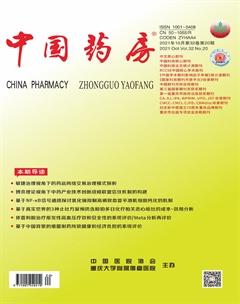HPLC-一测多评法同时测定壮药罗汉茶中6种黄酮类成分及多元统计分析
燕霞 朱雪妍 何颂华 张慧 罗轶 黄清泉



中圖分类号 R284 文献标志码 A 文章编号 1001-0408(2021)20-2485-07
DOI 10.6039/j.issn.1001-0408.2021.20.09
摘 要 目的:建立同时测定罗汉茶中新落新妇苷、落新妇苷、新异落新妇苷、异落新妇苷、槲皮苷和黄杞苷含量的方法,并进行多元统计分析。方法:采用高效液相色谱-一测多评法。色谱柱为Phenomenex SuperLu C18,流动相为乙腈-0.1%甲酸溶液(19 ∶ 81,V/V),检测波长分别为254 nm(新落新妇苷、落新妇苷、新异落新妇苷、异落新妇苷、黄杞苷)、291 nm(槲皮苷),流速为1.0 mL/min,柱温为30 ℃,进样量为10 μL。以落新妇苷为内参物,计算其他5种成分的相对校正因子,再根据相对校正因子计算各成分的含量,并与外标法进行比较;采用SPSS 22.0软件进行聚类分析和主成分分析。结果:新落新妇苷、落新妇苷、新异落新妇苷、异落新妇苷、槲皮苷和黄杞苷检测进样量的线性范围分别为0.007~0.311、0.871~18.184、0.002~0.119、0.052~1.251、0.105~2.202、0.020~2.319 μg(r>0.999);精密度、重复性、稳定性(24 h)试验的RSD均小于3%;平均加样回收率分别为97.32%、94.89%、97.15%、96.90%、97.52%、97.53%(RSD为1.09%~2.60%,n=6)。新落新妇苷、新异落新妇苷、异落新妇苷、槲皮苷、黄杞苷相对于落新妇苷的平均相对校正因子分别为1.252 6、1.198 3、0.958 6、0.807 1、1.138 1。一测多评法测得新落新妇苷、新异落新妇苷、异落新妇苷、槲皮苷、黄杞苷等5种成分的含量分别为0.394 2~2.067 2、0.139 1~0.804 7、2.864 8~8.554 8、4.581 2~11.371 1、1.028 9~13.401 5 mg/g;外标法测得新落新妇苷、落新妇苷、新异落新妇苷、异落新妇苷、槲皮苷和黄杞苷等6种成分的含量分别为0.367 2~1.925 3、46.361 1~126.342 1、0.138 1~0.798 8、2.966 2~8.857 8、4.642 5~11.523 3、0.970 6~12.641 9 mg/g;两种方法含量测定结果的相对误差均不高于3.55%。聚类分析结果显示,9批罗汉茶样品可聚为两类,S8聚为一类、其余聚为一类。主成分分析结果显示,前2个主成分的累计方差贡献率为84.745%,分类结果与前者一致。结论:所建高效液相色谱-一测多评法准确、可行,重复性良好,可用于罗汉茶中6种黄酮类成分的同时测定,并可为其质量控制提供参考。
关键词 罗汉茶;高效液相色谱法;一测多评法;黄酮;含量;聚类分析;主成分分析
Simultaneous Determination of 6 Flavonoids in Zhuang Medicine Engelhardia roxburghiana by HPLC-QAMS and Multivariate Statistical Analysis
YAN Xia,ZHU Xueyan,HE Songhua,ZHANG Hui,LUO Yi,HUANG Qingquan(Guangxi Zhuang Autonomous Region Institute for Food and Drug Control/NMPA Key Laboratory for Quality Monitoring and Evaluation of Traditional Chinese Medicine, Nanning 530021, China)
ABSTRACT OBJECTIVE: To establish a method for simultaneous determination of neoastilbin,astilbin,neoisoastilbin,isoastilbin,quercitrin and engeletin in Engelhardia roxburghiana, and conduct multivariate statistical analysis. METHODS: HPLC-QAMS method was adopted. The determination was performed on Phenomenex SuperLu C18 column with mobile phase consisted of acetonitrile-0.1% formic acid (19 ∶ 81, V/V) at the flow rate of 1.0 mL/min. The detection wavelengths were set at 254 nm (neoastilbin, astilbin, neoisoastilbin, isoastilbin, engeletin) and 291 nm (quercitrin). The column temperature was 30 ℃, and sample size was 10 μL. Using astilbin as internal substance, and the relative correction factors of other 5 factors were calculated. The contents of each component were calculated according to relative correction factor, and were compared with the results of external standard method. SPSS 22.0 software was used for cluster analysis and principal component analysis. RESULTS: The linear range of neoastilbin,astilbin,neoisoastilbin,isoastilbin,quercitrin and engeletin were 0.007-0.311, 0.871-18.184, 0.002-0.119, 0.052-1.251, 0.105-2.202, 0.020-2.319 μg (r>0.999), respectively. RSDs of precision, reproducibility and stability (24 h) tests were all lower than 3%. The average recoveries were 97.32%, 94.89%, 97.15%, 96.90%, 97.52% and 97.53% (RSDs were 1.09%-2.60%, n=6), respectively. The relative correction factors of neoastilbin,neoisoastilbin,isoastilbin,quercitrin and engeletin were 1.252 6,1.198 3,0.958 6,0.807 1 and 1.138 1, respectively. The contents of neoastilbin, neoisoastilbin,isoastilbin,quercitrin and engeletin measured by QAMS were 0.394 2-2.067 2,0.139 1-0.804 7,2.864 8-8.554 8,4.581 2- 11.371 1,1.028 9-13.401 5 mg/g; the contents of neoastilbin,astilbin,neoisoastilbin,isoastilbin,quercitrin and engeletin were 0.367 2-1.925 3, 46.361 1-126.342 1, 0.138 1-0.798 8,2.966 2-8.857 8,4.642 5-11.523 3,0.970 6-12.641 9 mg/g,respectively. Relative errors of two methods was lower than or equal to 3.55%. The results of cluster analysis showed that 9 batches of samples could be clustered into two categories; S8 sample was one category and others were one category. The results of principal component analysis showed that accumulative contribution rate of former 2 principle components was 84.745%, and the results of sample classification were consistent with those of cluster analysis. CONCLUSIONS: The established HPLC-QAMS method is accurate,feasible and repeatable,and can be used for simultaneous determination of 6 flavonoids in E. roxburghiana, and it can provide reference for quality control.

